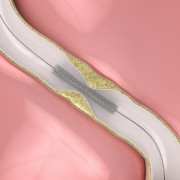First absorbable stent approved by FDA
The US Food and Drug Administration have approved a fully absorbable stent that can limit complications for coronary artery disease, such as the growth of scar tissue in the arteries

Coronary heart disease (CHD) occurs when plaque, a waxy substance, builds up inside the coronary arteries. Over time, this plaque narrows the arteries, reducing the flow of oxygen-rich blood to the heart. Such blockage can lead to chest pain (angina) or a heart attack, according to the National Heart, Lung, and Blood Institute.
To treat a heart attack or reduce its symptoms, such as chest pains, surgeons are able to implant expandable tubes, called stents, that can widen arteries, according to WebMD. Before the use of expandable tubes, an angioplasty, typically performed with metal stents, was the common method to widen arteries, but the procedure carried the risk that scar tissue could form, causing the artery to narrow again, a condition called restenosis.
A new product, approved by the US FDA on July 5, now reduces such complications. Called the Absorb GT1 Bioresorbable Vascular Scaffold System (BVS), it is the world’s first fully absorbable stent which can also limit the growth of scar tissue through release of the drug ‘everolimus.’ BVS is also designed to begin breaking down after about one year and be fully absorbed by the body in approximately three years, according to Medical News Today.
The Absorb GT1 BVS is made from a biodegradable polymer called poly(L-lactide), similar to material used in certain sutures or other types of absorbable medical devices. Foreign material in the artery is eliminated or absorbed by the body after the stent is no longer needed. What remains are four tiny platinum markers embedded in the walls of the artery, which serve as signposts for where the stent was originally placed.
Medical News Today reported that the risks involved in using the Absorb GT1 BVS include allergic reactions to materials in the device, allergic reactions to the drug everolimus, possible infection or irritation at the catheter insertion site, internal bleeding, blood clots in the bloodstream (embolism) and the development of abnormal connections between arteries and veins. These are the same risks present in using metallic stents. The FDA also found that the risk of a major adverse cardiac event was similar between using BVS and drug-releasing metallic stents.
Related Articles
Why laughter may not be the best medicine
Dr Julian K.B. Tan, an interventional cardiologist at Mount Elizabeth Hospital, explains the how strong emotions may affect the heart
Read moreWhat is a heart attack?
Dr Paul Chiam discusses the importance of seeking treatment quickly in the case of a heart attack
Read moreLatest Articles
Medical Care
Achieving Swift Recovery: Enhanced Recovery (ERAS) Direct Anterior Approach Total Hip Replacement
Consider total hip replacement with Alps Orthopaedic Centre's ERAS Direct Anterior Approach for faster recovery and reduced hospital stays. Learn about Dr. Jerry Chen's expertise in Singapore.
Read moreMedical Care
Enhanced Recovery (ERAS) Total Knee Replacement
Discover how Alps Orthopaedic Centre's Enhanced Recovery After Surgery (ERAS) approach transforms total knee replacement into a day surgery, offering faster recovery, less pain, and reduced hospital bills. Learn about Dr. Jerry Chen's expertise and schedule your appointment in Singapore.
Read moreMedical Care
Clinical Exercise Physiologist (CEP): The Emerging of Exercise is Medicine
How Exercising can be a Medicine
Read more